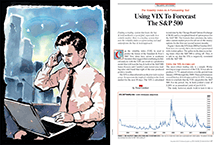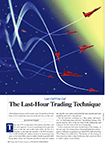LETTERS TO THE EDITOR
February 2013 Letters To The Editor
The editors of S&C invite readers to submit their opinions
and information on subjects relating to technical analysis and this magazine.
This column is our means of communication with our readers. Is there something
you would like to know more (or less) about? Tell us about it. Without a source
of new ideas and subjects coming from our readers, this magazine would not
exist.
Address your correspondence to: Editor, Stocks & Commodities,
4757 California Ave. SW, Seattle, WA 98116-4499, or E-mail to editor@traders.com.
All letters become the property of Technical Analysis, Inc. Letter-writers
must include their full name and address for verification. Letters may
be edited for length or clarity. The opinions expressed in this column do not
necessarily represent those of the magazine. —Editor
THE CAT’S EARS PATTERN
 Editor,
Editor,
Please extend my thanks to Giorgos Siligardos for his December 2012 article, “The Cat’s Ears Pattern.” I found the article well written and it adds a twist to the traditional take on double tops, especially when paired with the RSI. I look forward to testing it and to see whether a reliable bottom version exists.
Thomas Bulkowski
S&C Contributing Writer and
author
of Encyclopedia Of Chart Patterns
MISH SCHNEIDER INTERVIEW
 Editor,
Editor,
Your interview with Mish Schneider was wonderful (“Michele ‘Mish’ Schneider Of MarketGauge,” Stocks & Commodities, November 2012). I am saving it to reread in the future. Thank you to her for the great detail and wonderful information.
Becky McClain
CLARIFICATION: METASTOCK REVIEW
In our review of Meta-Stock 12 in the January 2013 S&C, the name of the datafeed given was “Eikon for Retail Traders.” MetaStock reports that the name of that datafeed has since changed to “MetaStock XENITH.”
VIX STRATEGY
 Editor,
Editor,
Thanks for Trent Gardner’s work presented in the December 2012 issue of S&C. I have a question for him about applying a stop or loss limit component.
I’ve been tinkering with some think-Script to implement the strategy he discusses.
It seems to me that there should be a stop of some logical construction rather than an “always in” mode — if only to avoid the mandatory 11 days that the system will suffer through drawdowns.
Perhaps the author will have some suggestions (other than what he’s already suggested in his article) to address the matter of a strategy to avoid the extreme drawdown exposure. Aside from a cold, hard-dollar or percentage loss stop — which I find tends to lock in losses rather than ride out extreme swings that seem to invariably revert to the mean — I was thinking along the lines of a maximum number of days to stay in the position before expecting profit; or perhaps a mechanism that would go flat after the VIX crossed its 50-period moving average (MA) or some other technical analysis event that can be proven to occur in relation to a losing trade.
Moreover, in his article text, he writes: “You can try to vary the number of consecutive days to see what gives you better results. I added the additional requirement that the VIX must be above the moving average for nine consecutive days. This resulted in 18 trades over a five-year period.”
However, I don’t understand this comment. Is he suggesting that a stop is triggered when the VIX fails to maintain nine consecutive trailing days on one side or the other of its 50 SMA? (I'll give that a try in any case.)
Once again, as a long-time retail trader who has “seen it all” since I began trading options circa 2001, it’s refreshing to read an article that is simple, straightforward, logical, and above all else, potentially lucrative in its content!
It was actually on reading this S&C article of Gardner’s on the VIX strategy that I decided to buy a subscription to S&C magazine — something I’ve not done for any magazine in many years.
Adam
Author Trent Gardner replies:
Thanks for the comments. Here are some answers to your questions:
- I don’t know how to avoid the large drawdown that the system can experience. It happens when the market panics and without any warning. The best thing to do is think of a way to modify the risk. One method is to invest in high-yield bonds through an actively managed fund. High-yield funds tend to lose less on big down days and the drawdown is modest.
- My comment on trying different parameters such as nine days versus 11 days was meant to inform the reader that the system can be changed without losing the performance. It wasn’t meant to suggest new rules.
- This article was meant to stimulate thinking about uses for the VIX. There are some academic articles that suggest the VIX can forecast market changes, and I am interested in finding out how to do that.
- Just to clarify, I am not actually on the S&C magazine staff; my article was a freelance contribution. I am a student at Embry Riddle University in Prescott, AZ.
I hope this helps.
EDUCATIONAL MAGAZINE
 Editor,
Editor,
I read your Opening Positions and articles in the October and November 2011 issues of Stocks & Commodities. I want to compliment your outstanding writing and analysis of the European markets and the overall stock market. You have the knowledge of someone who is a trader in addition to being an editor. Someone with this knowledge of the stock market is an asset to your subscribers. I regret canceling my subscription and am on the verge of resubscribing after reading those two issues, which impressed and educated me.
Paul Shepherd
Bronx, NY
INTEGRATING TIME FRAMES
 Editor,
Editor,
I really enjoyed BC Low’s article in the November 2012 issue on using ADX to determine the start of the trend (“Identify The Start Of A Trend With DMI”).
I have a question, however. At the end of the article, he mentions that the signals are applicable in all time frames: daily, weekly, and beyond. Has he tried these signals in a lower time frame (for example, a four-hour chart in forex)? I’ve been trading mainly using ichimoku on the daily chart to determine my bias. However, I usually try to time my entries using lower time frames — that is, H1 and mostly H4.
FX Hilton
Author BC Low replies:
I am glad you enjoyed the article, and I hope the technique works out for you one way or another.
Unlike many traders, I am not a short-term market person. It is a matter of preference and trading philosophy. As such, I tend to use my techniques in the daily or larger time frames. But I do integrate these different time frames quite a bit and they work out well overall. Given that, I cannot really advise you on the hourly time frames, but I suspect the technique still applies. However, on shorter time frames, the effect or impact is much quicker and smaller.
METATRADER 4 CODE
Editor,
I am employed as a daytrader in the forex market. I have read with interest BC Low’s article in November 2012 S&C. The average directional movement index is my favorite indicator. For my trading, I utilize the MetaTrader 4 platform through FXCM. Can you suggest how I can translate the code into MetaTrader 4? I should like to learn your method and apply it to my trading.
Vartan
Author BC Low replies:
I’m glad you find the article interesting. I hope you will find it helpful in your trading as well. Using the clusters involves some finer points, which require you to follow the workings of the clusters. Although I find them very useful and have been using them for a couple of years, I am still learning more about them as I go.
As for the MetaTrader 4 software, I am afraid I cannot advise you since I don’t use it. But basically, the clusters are easy to recreate. Just vary the numbers used for three groups, ADX, +DI, and -DI, and pay attention to the reference high & low levels of each cluster.
Editor’s note:
Users of MetaTrader 4 can visit the software’s user forum at https://www.metatrader4.com/ru/forum for idea exchange and to post questions. However, the forum is in Russian.
Users of MetaTrader 5 can visit the MQL5 user forum (primarily in English) at https://www.mql5.com/en and find a large user-provided code library at https://www.mql5.com/en/code. You can try searching for custom code there.
LAST-HOUR TRADING
 Editor,
Editor,
I just wanted to tell you how much I enjoyed Ashwani Gujral’s article in the August 2012 issue on last-hour trading (“The Last-Hour Trading Techniques”). I have observed for a long time that after a large up or down gap on the open, the markets often go nowhere for the rest of the day. Trying to force a trade on these days is most often a losing proposition.
I am most comfortable trading SPY, the QQQs, and VXX. Does Gujral find that his methodology works as well with that type of trading vehicle?
I also have a few more questions:
- In his article, he also mentions “higher throughout the day or keeping a positive bias, you look for stocks to buy and vice versa.” I have seen many times when the bias for the day is up, but in the last hour it begins to go down on heavy volume. Do we only rely on the last-hour direction, and if so, does the direction for the earlier part of the day matter?
- What time interval does Gujral set his charts for to check direction? I have seen some charts that appear to have a last-hour up bias, but when viewed on a shorter time frame like a five-minute, the last few bars may go the opposite direction on the heaviest volume of the day. A one-minute chart really points this out.
I guess I’m asking whether the last-hour price direction has to match the rest of the day to qualify for his method, or are we only to consider the direction of the last hour. What do we do if the last 15 minutes of the last hour reverses direction from the earlier part of the last hour on heavier volume? Do we consider the entire last hour, or are the final few minutes of the last hour the most important if volume is heavy and if the last few minutes change direction?
Dale
Author Ashwani Gujral replies:
Thanks for your kind words. The methodology works with all instruments because it works a basic market tendency where 90% of all moves at the closing show follow-through the next day. Obviously, there are other factors that can be used to fine tune and filter, but this basic market tendency does work all the time.
I will answer your remaining questions point-wise:
- As you may be aware, there are two types of days: trend days (that is, ones that open higher/lower, keep going higher/lower, and close at the high/low of the day), and choppy days (those that just chop around and close unchanged). Mildly bullish/bearish days bring slow upmoves/downmoves.
- You have to perform analysis on several levels. First, develop the big picture: Look at the daily trend, look for a setup like breaking out of a low volatility area or getting into a trend on a decline, and then look at a five-minute chart in the last couple of hours of the market.
- The idea is: On a bullish or mildly bullish day, look for the strongest sector that is starting a fresh rally (and similarly, on a bearish day, choose stocks or sectors that are starting a fresh decline). You need a sense of the overall environment for best results.
Originally published in the February 2013 issue of Technical Analysis of Stocks & Commodities magazine. All rights reserved. © Copyright 2013, Technical Analysis, Inc.
Return to
Contents
 Editor,
Editor, Editor,
Editor, Editor,
Editor, Editor,
Editor, Editor,
Editor, Editor,
Editor,